E.G. Lewis's Blog, page 6
April 13, 2012
FOODS OF THE FIRST CENTURY: SALADS & GREENS
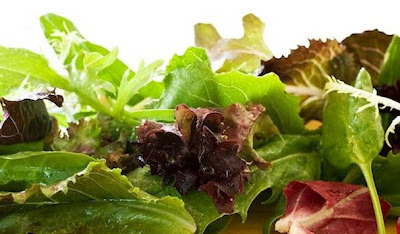
Hello My Friends and Welcome.
As we move forward on these posts of Foods of the First Century, we will be making a few additions and clarifications to the series. For instance, our list of spices contained all of the items readily available to the typical homemaker. Other Indian spices, especially black pepper, would also have been available. However, pepper traded at more than its weight in gold, making it beyond the reach of all but the very rich.
Proof of the vigorous spice trade that existed between India and what became the Greco-Roman world is found in Genesis 37:25, where Joseph’s brothers sell him into slavery. “And they lifted up their eyes and looked, and behold, a company of Ishmaelites (Arabs) came from Gilead with their camels bearing spicery and balm, and myrrh, going to carry it to Egypt."
THE BERNIKE CONNECTIONRoman historian Strabo mentions a vast increase in trade following the Roman annexation of Egypt. The city of Bernike, which lay at the southeastern extreme of the Roman Empire, functioned as a transfer port for goods shipped through the Red Sea. Trade activity peaked in the First Century. Ships would sail between Berenike and India during the summer, when monsoon winds were strongest. From Berenike, camel caravans carried the goods 240 miles west to the Nile, where they were shipped by boat to the Mediterranean port of Alexandria. From there, they could be moved throughout the Roman world. By the time of Augustus up to 120 ships set sail for India each and every year. This maritime network continued until the fall of the Roman Empire when Rome lost its Red Sea ports.
ASPARAGUS – A MEDITERRANEAN NATIVE Moving on to vegetables, we overlooked asparagus. A native of Mediterranean area and Asia Minor, it can be traced back as far as 200 BC. Both Julius Caesar and Augustus are known to have prized asparagus. Interestingly enough, almost 2,000 years before Clarence Birdseye introduced commercially frozen foods, the Romans ate froze asparagus. How, you ask? Clever devils that they were, they kept it frozen in the Alps for special Feasts.
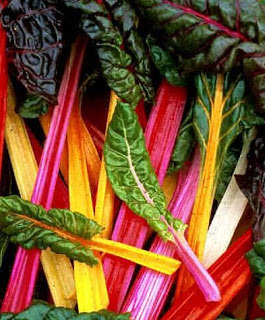 Bright Lights Swiss ChardMOVING ON TO SALADS & GREENSBefore we get into salads, there is a misunderstanding that needs to be put to rest. Neither Julius Caesar, nor any of the other Caesars for that matter, ever dined on Caesar Salad. This famous dish was invented over a Fourth of July weekend in 1924 in Tijuana, Mexico by restaurateur Caesar Cardini.
Bright Lights Swiss ChardMOVING ON TO SALADS & GREENSBefore we get into salads, there is a misunderstanding that needs to be put to rest. Neither Julius Caesar, nor any of the other Caesars for that matter, ever dined on Caesar Salad. This famous dish was invented over a Fourth of July weekend in 1924 in Tijuana, Mexico by restaurateur Caesar Cardini. 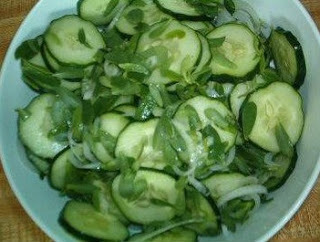 Purslane-Cucumber SaladDANDELION GREENSI recall seeing women gathering dandelion greens when I was a child. Nowadays, dandelion has been replaced by endive. Ironically, many of the trendy greens being featured in cookbooks and on the Food Channel are the same ones that the ancients consumed. They’ve been overlooked to such an extent that some are now treated as ornamentals or, worse yet, weeds. Most can easily be gathered wild just as they were in the First Century.
Purslane-Cucumber SaladDANDELION GREENSI recall seeing women gathering dandelion greens when I was a child. Nowadays, dandelion has been replaced by endive. Ironically, many of the trendy greens being featured in cookbooks and on the Food Channel are the same ones that the ancients consumed. They’ve been overlooked to such an extent that some are now treated as ornamentals or, worse yet, weeds. Most can easily be gathered wild just as they were in the First Century. 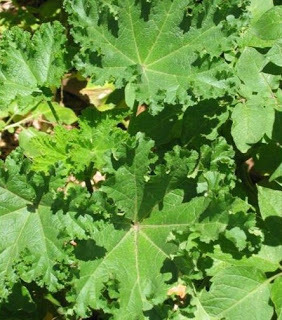 Curly Malow LeavesCheck out some of the accompanying photos. Not only were these greens tasty and nutritious, but the color and variety provided a feast for the eye. Besides leaf lettuce, people of the First Century ate rocket, roquette, also known as arugula— watercress, mallow, sorrel and goosefoot. Goosefoot belongs to the genus Chenopodium which includes Bright Lights Swiss Chard, Tyee Spinach, and Aurora Orach, or Mountain Spinach, which has edible leaves in a rainbow of pastel colors. They also ate purslane, chicory, chervil, and beet greens.
Curly Malow LeavesCheck out some of the accompanying photos. Not only were these greens tasty and nutritious, but the color and variety provided a feast for the eye. Besides leaf lettuce, people of the First Century ate rocket, roquette, also known as arugula— watercress, mallow, sorrel and goosefoot. Goosefoot belongs to the genus Chenopodium which includes Bright Lights Swiss Chard, Tyee Spinach, and Aurora Orach, or Mountain Spinach, which has edible leaves in a rainbow of pastel colors. They also ate purslane, chicory, chervil, and beet greens. Aurora Orach Spinach
Aurora Orach SpinachA FIRST CENTURY SALAD RECIPEHere’s a salad recipe from Around the Roman Table: Food and Feasting in Ancient Rome by Patrick Faas. I’ve added approximate quantities where I could. Columella’s salad: Put savory in the mortar with mint (3 ½ oz.), rue, fresh coriander (cilantro) (1 ¾ oz), parsley (1 ¾ oz), a sliced leek or, if not available, onion, lettuce and rocket leaves, green thyme, or catmint(1 sprig). Add salted fresh cheese (7-8 oz.). This is all crushed together. Stir in a little peppered vinegar. Put on a plate and pour oil over it. (Columella, Re Rustica, XII) Columella added nuts to some of his other salads. Pine nuts might go nicely in this one.Next time we revisit Foods of the First Century, we’ll examine Grains. On Friday, we’ll re-activate our series on Ancient Games and look at the Roman Game of Calculi. Until then, we wish you Peace and Blessings.If you reached this post via a link, click the HOME tab above to see other posts and our archives.
Published on April 13, 2012 02:00
April 11, 2012
FREE PROMOTION - PROMISES by E G LEWIS
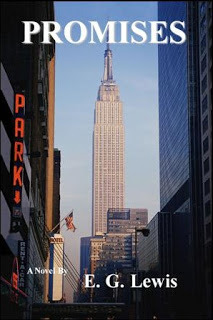
Hello My Friend and Welcome.
Today we have a special announcement for Sowing the Seeds readers regarding the Free Promotion of my novel, PROMISES. That's right, the Kindle edition will be free on Amazon all day today and tomorrow. If you are an eReader, I urge you to follow THIS LINK to download your free copy. I've included a synopsis and excerpts of several reviews below.
Smooth as a sip of Kentucky Bourbon, PROMISES eases you into the Appalachian hill country. That wonderfully wild place of mountains and hollows, creeks and rivers, with its hardscrabble life and whiteboard churches where roots go deep, family matters, and Granny Wright is never wrong. A place where King Coal still rules, and beneath its veneer of respectability lays a hidden web of treachery. Mary Jane Combs may have gotten her Momma's good looks, but her strong-willed determination came straight from Daddy. Growing up in Kentucky she dreamed of a simple life with a loving husband, a home of her own, and healthy kids.
Instead she's become an international Supermodel, swapping the Appalachian coal country for New York City's Upper West Side and traveling the world in her private jet. Now she'll need all the determination she can muster when her ex-husband sets out to destroy everything she's accomplished. But two questions remain unanswered: Can she do what needs to be done and still remain true to the promises she made at her mother's deathbed? And when the dust settles, will she at last find the loving relationship she always dreamed of as a girl?Part coming of age, part romance, and 100% fun reading, PROMISES is one of those unique novels that keeps getting better and better. After letting his readers settle into life in Appalachian Kentucky, Mr. Lewis catapults them and his strong female protagonist, off to New York, London, Paris, and beyond. But whatever the situation, she keeps her cool and responds with grace and courage forever destroying the myth of the dumb blond. —Brian Nolan for Northwest Book Review
PROMISES by E.G. Lewis was certainly not what I was expecting, and in this case that is a good thing! Rather than a fluffy romance, I got a well written novel with substance. It is the epic journey of a woman who rises above the trials of life to become the person she was meant to be all along. It starts when Mary Jane is just 15, on the eve of her mother's funeral. From there it takes us through her struggles at home and at college, first love, more tragedy, success, fame, fortune, betrayal, revenge … pretty much the whole gamut of human emotion! At first glance, this list almost sounds trite, but Lewis's writing is so provocative, so descriptive, so in tune with the human psyche, that this book is anything but cliché. He draws us into MJ's world with such craft and precision that before you know it you just have to keep reading. I highly recommend it. —Tracy Krauss for Expression Express
In PROMISES, young girl endures hardship to become a highly successful super model traveling the world. Yet her fame and fortune are threatened when an unscrupulous entrepreneur tricks her into marriage. What follows is immensely satisfying. Although she endures humiliation and her career is damaged at his hands, she retaliates in a way only a strong, intelligent woman could.
The novel has a strong sense of place: Kentucky, New York, Paris and the Caribbean; lots of interesting information about the stock market and how public corporations function. Hard work and family loyalty help her overcome obstacles and succeed.
Despite the fact that she's neither a dumb blond, nor an easy lay, Claudia's life is not without romance. This great story concludes with a wonderful feel good ending. I loved the characters and loved the story. It's a rewarding read. I adored Claudia Monet and HIGHLY RECOMMEND this novel to everyone. —Zara Heritage for Summit Book Reviews
Get your free copy of PROMISES for the Kindle by clicking HERE!
Next time we'll return to our Foods of the First Century.
Until then, We wish you Peace and Blessings
Published on April 11, 2012 01:00
April 10, 2012
THE SAMARITAN PASSOVER
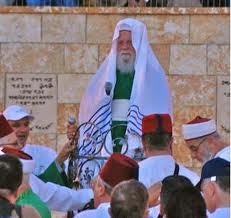 Samartin High Priest in Green
Samartin High Priest in GreenHello My Friend and Welcome.If you've been following our series of Lenten/Easter posts, you may recall the one on how the date of Easter is determined. (If you missed it, you can find it HERE.) In the post we pointed out that the Western Church adheres to the Gregorian calendar when calculating the date of Easter. In contrast, the Eastern Church uses the Julian, or Roman, calendar. Because of this difference, some years both branches of Christianity celebrate Easter on the same day and other years the dates are widely divergent.
It so happens that a similar situation exists with our Jewish brethren. This year, the Jews celebrated Passover on April 6th, whereas the Samaritans will celebrate on May 4th. There still exists today a small group of Samaritan Jews. These Samaritans adhere to the Torah – the first five books of the bible – but end up celebrating the Passover on a different date than the Jewish people who follow rabbinic laws. Still, one suspects the Samaritan traditions may possibly resemble the ancient traditions to a greater degree than those of the rabbinical Judaism.
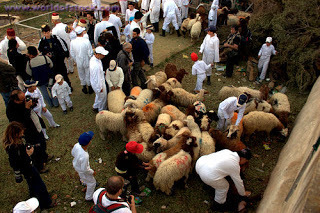 Gathering the Lambs for PassoverAny reader of the Bible is surely aware of the animosity that existed between the Jews and the Samaritans in the First Century. Actually, the ill feelings between them can be traced all the way back to the lost tribes. Following Solomon's death his son, Rehoboam (Hebrew: רְחַבְעָם, Rehav'am, meaning "he who enlarges the people") became king of the United Monarchy of Israel. The ten northern tribes of Israel rebelled in 932/931 BC to form the independent Kingdom of Israel and invited Rehoboam's brother, Jeroboam (Hebrew: יָרָבְעָם, yarobh`am, meaning "he pleads the people's cause") to be their king. Rehoboam retreated and resurrected his grandfather David's Kingdom of Judah (in Latin Judaea).
Gathering the Lambs for PassoverAny reader of the Bible is surely aware of the animosity that existed between the Jews and the Samaritans in the First Century. Actually, the ill feelings between them can be traced all the way back to the lost tribes. Following Solomon's death his son, Rehoboam (Hebrew: רְחַבְעָם, Rehav'am, meaning "he who enlarges the people") became king of the United Monarchy of Israel. The ten northern tribes of Israel rebelled in 932/931 BC to form the independent Kingdom of Israel and invited Rehoboam's brother, Jeroboam (Hebrew: יָרָבְעָם, yarobh`am, meaning "he pleads the people's cause") to be their king. Rehoboam retreated and resurrected his grandfather David's Kingdom of Judah (in Latin Judaea).Fast forward a couple of hundred years and the Assyrians invade the Northern Kingdom, carry away the people into captivity, and force them to intermingle with other peoples under their control. Hence, the famous lost tribes of Israel. To destroy any remnant and prevent the Jews from ever reclaiming the territory, the Assyrians moved other alien races into the area. [This is not unlike what the Chinese are currently doing by flooding Tibet with Han Chinese.] These new people eventually adopted the beliefs and practices of the Jews, becoming, in effect, converts to Judaism. Because of the method by which they came to the faith, the Jews refused to accept them and banned them from worshipping at the Temple in Jerusalem. The Samaritans responded by building their own Temple at Mt Gerizim.
All of this is back story to introduce the irony of today's post. Nearly two millennia after the destruction of Jerusalem and Herod's Temple it is the Samaritans, not the Jews, who still adhere to the old sacrificial laws. Some forty miles north of Jerusalem, an annual event occurs that transports the modern person thousands of years back in history. The Samaritan Passover has, for over two thousand years, been observed on Mt. Gerizim and Samaritans still continue to gather there to offer the sacrifices prescribed in the Torah (Pentateuch).
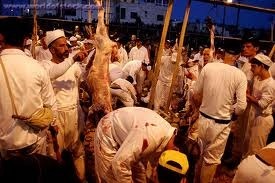 Preparing the LambsThe Jewish people celebrate Passover each year, of course, but since the temple in Jerusalem was leveled by the Romans in A.D. 70, they have not offered the biblically mandated sacrifices. The Samaritans, by contrast, owed no allegiance to the Jerusalem Temple and held their sacrificial services on Mt. Gerizim. A reference in the New Testament makes this clear when the woman at the well asked Jesus if worship should be held on Mt. Gerizim or in Jerusalem (John 4:20). Excavations are now underway on the Samaritan temple that was constructed in the 4th century B.C. and destroyed in the 2nd century B.C. Even after their temple was destroyed, the Samaritans continued to offer sacrifices on Mt. Gerizim, and do so to this day.
Preparing the LambsThe Jewish people celebrate Passover each year, of course, but since the temple in Jerusalem was leveled by the Romans in A.D. 70, they have not offered the biblically mandated sacrifices. The Samaritans, by contrast, owed no allegiance to the Jerusalem Temple and held their sacrificial services on Mt. Gerizim. A reference in the New Testament makes this clear when the woman at the well asked Jesus if worship should be held on Mt. Gerizim or in Jerusalem (John 4:20). Excavations are now underway on the Samaritan temple that was constructed in the 4th century B.C. and destroyed in the 2nd century B.C. Even after their temple was destroyed, the Samaritans continued to offer sacrifices on Mt. Gerizim, and do so to this day.People come from all over the world to witness the Samaritan Passover. If you can get beyond the crowds and the noise, you can almost imagine yourself back in Second Temple period and feel like you are actually present at the sacrifices as they once were. Come to think of it, keep the crowds and the noise and the experience would probably be closer to how it really was.
The service begins at sunset. The Samaritan men dress in white garments, the leaders wear red hats, and the priests wear a distinctive turquoise-green garb. The Samaritans begin chanting and praying. When the signal is given, the head of each household reaches for his knife to slice the throat of his family's lamb. As soon as the deed was done, the Samaritans begin celebrating. Recently, about thirty-five sheep were slain, about one for each larger family unit (no more than 600 Samaritans remain ). Then the sheep are skinned and put on a pole and carried over to one of the roasting pits to be cooked for most of the night.
A sacrifice is a bloody process and the men end up with blood on their hands and all over their clothes. To the Samaritan or the ancient Israelite, the Mosaic statement, "the life is in the blood," must have left a profound impression of the cost of the sin which required such a sacrifice. Christians today in the sterile environment of the sanctuary may miss the benefit of understanding the gravity of sin that was such an integral part of the life of the Israelites.
Drop by tomorrow for a special, money-saving announcement. On Friday, we'll resume our series on Foods of the First Century with a look at salad greens and ancient recipe for Columella's salad. Until then, we wish you Peace and Blessings.
If you reached this post via a link, click the HOME tab above to see other recent posts and visit our archives.
Published on April 10, 2012 01:00
April 9, 2012
PASSING ON THE FAITH IN THE EARLY CHURCH
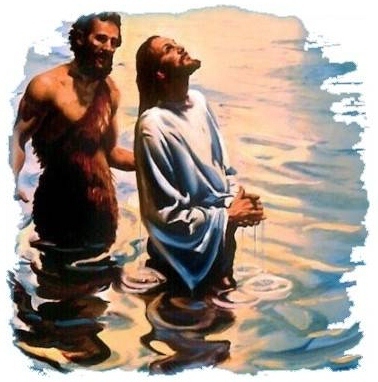 The Baptism of Jesus in the Jordan
The Baptism of Jesus in the JordanHello My Friend and Welcome. Before we leave Easter behind, this seemed like the opportune time to examine the Early Church's process of formation leading to Baptism. This post was also motivated by research findings from my Seeds of Christianity™ Series.
Somewhat surprisingly, the preparation required for acceptance into the Church has varied over time. In APOSTLE, the third book of the Series, the Church at Antioch was preparing to celebrate the Pascha, or Feast of the Lord's Resurrection. This was the time when new catechumens were baptized and brought into full fellowship with the congregation. Like the current Mass, early worship was divided into parts, principally the Introductory Rites, the Liturgy of the Word and the Liturgy of the Eucharist. Prior to their Baptism, catechumens left after the Liturgy of Word —the Scriptural Readings. Since they were not yet full members, it would have been inappropriate for the catechumens to participate in the profession of faith, or Creed, and the breaking of the bread and sharing of the cup, as St. Paul calls it in 1 Corinthians.
It should be clear that we are speaking of initiation into the Church via Baptism, not the Jesus Prayer which has become popular in recent years. The Jesus Prayer was developed by traveling evangelists for their tent meetings as a method of formalizing a person's commitment when Baptism was either unavailable or inconvenient. Unfortunately, this prayer has begun to supplant Baptism in some circles. Historically, the Church has always adhered to the Great Commission as expressed in Matt. 28:19 "…Go therefore and make disciples of all nations, baptizing them in the name of the Father and of the Son and of the Holy Spirit…"
IN THE APOSTOLIC ERADuring the period immediately after Pentecost and in the earliest years of the Church, acceptance into the Church was quick and simple. Many examples can be found in Acts of the Apostles. For instance, Acts 2 tells of the coming of the Holy Spirit at Pentecost and, in its concluding verses says, "So those who received his word were baptized, and there were added that day about three thousand souls." The apostles started the morning still awaiting the Paraclete; they clearly hadn't developed any program for the formation of catechumens.
Early in Acts 4 we find Peter preaching in the Temple and it says, "But many of those who heard the word believed; and the number of the men came to about five thousand." From this passage it's unclear whether Luke is giving us a cumulative total or the number of new converts. Either way, at the very least they've added 2,000 more.
Let's skip to Acts 8:5, where we find Phillip, the evangelist, not the apostle, in Samaria preaching and baptizing. In Acts 8:26-39, Phillip encounters the Ethiopian eunuch, preaches to him, and the eunuch says, "See, here is water. What is to prevent my being baptized?" He baptizes the man without hesitation. In Acts 10 Peter is in Caesarea. He's called to the home of Cornelius the Centurion and baptizes his whole household.
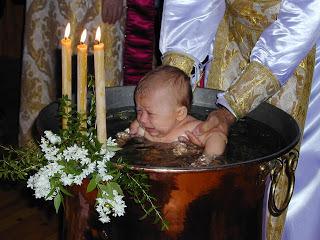
IN THE POST-APOSTOLIC ERA
If we fast forward a bit, we find that the Church has instituted a systematic process of formation prior to baptism. Rather than what we've seen in Acts, aspiring Christians must first become catechumens (those who were under instruction). The candidates enter this state when they present themselves to the catechists (instructors) and their names are inscribed on a list kept by the deacons. During this act of enrollment the aspirants are accompanied by some of the believers who testify to their right intentions and true commitment to grow in the knowledge of the Christian faith. Thus the candidates' first steps were not taken alone, but in full sight of the community thanks to the presence of these witnesses who much later came to be known as godparents.
After the enrollment of names and presentation of the candidates, they went on to examine their lives, the occupations they followed and the motives which animated them. The questioning, often rigorous, was intended to assure the Church that the practical conditions existed for actually living the Christian life, uncompromised by pagan customs and immorality.
A detailed list of activities incompatible with being a Christian is furnished by a Third Century text called the Apostolic Tradition. "The trades and occupations of those being brought for instruction must be examined. If they run brothels, they must give them up or be sent away. If they are sculptors or painters they be told not to make representations of idols; they must give this up or be sent away. If they are actors, they must give this up or be sent away. If they are racing charioteers or participate in the public games, they must give this up or be sent away. If they are gladiators or train gladiators to fight, or are officials involved in arranging gladiatorial games, they must give this up or be sent away. Prostitutes, lechers, the dissolute and others we cannot speak well of, must be sent away because they are impure. Magicians must not be taken before the examiner. Forgers, astrologers, diviners, interpreters of dreams, charlatans, liars, makers of amulets, must give these up or be sent away. He who has a concubine must give her up and take a wife according to the law; if he won't he must be sent away."
SEARCHING FOR AN EXPLANATIONSo what is going on here? Several things are in play, actually. One might ask, "Why didn't the apostles scrutinize baptismal candidates in the initial stages of the Early Church?" Or, turning that around, "What changed that required candidates to be scrutinized so carefully?"
Let's retrace our steps back to the Acts of the Apostles. The very first believers on Pentecost were all Jews who had come to Jerusalem for the Feast of Weeks, or Pentecost, as it was called. Judaism had its own well-developed system of formation. Young men attended school at their local synagogue where a Rabbi trained them in the Torah―the Law, the Nevi'im―the Prophets, and the Ketuv'im―the Writings. At the time of a boy's Bar Mitzvah he was questioned on his knowledge and expected to be able to respond and debate intelligently. These new converts had already gone through an extended period of formation.
Consider also that in the very earliest of times, adherents to The Way of Yeshua still considered themselves Jews. It was only after the continuing persecutions and arrests by the High Priest and Temple authorities that they began to distance themselves from Judaism. These initial converts were not being asked to change their beliefs as much as they were being asked to expand them. In Matt 5:17 Jesus himself says, "Think not that I have come to abolish the law and the prophets; I have come not to abolish them but to fulfill them."
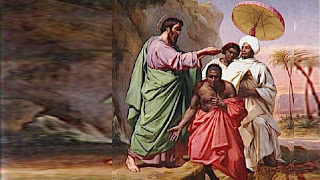 Phillip Baptizing the EunuchDespite any bad blood between the Jews and the Samaritans, the Samaritans were also trained in the faith and devout in their practices. That leaves us with the eunuch and Cornelius. Both of them were what the Jews called a God-fearer, someone who accepted and practiced the tenets of Judaism without formally converting. Reading between the lines of Acts, we might conclude that when the eunuch asks Phillip, "What is to prevent my being baptized?" It may have been his oblique way of asking, "Will you discriminate against me because I am a eunuch?" The Jews strongly disapproved of castration and had laws preventing eunuchs from the priesthood and other offices.
Phillip Baptizing the EunuchDespite any bad blood between the Jews and the Samaritans, the Samaritans were also trained in the faith and devout in their practices. That leaves us with the eunuch and Cornelius. Both of them were what the Jews called a God-fearer, someone who accepted and practiced the tenets of Judaism without formally converting. Reading between the lines of Acts, we might conclude that when the eunuch asks Phillip, "What is to prevent my being baptized?" It may have been his oblique way of asking, "Will you discriminate against me because I am a eunuch?" The Jews strongly disapproved of castration and had laws preventing eunuchs from the priesthood and other offices. A CHANGING SITUATIONContrast the situation Peter faced on Pentecost to what the Post-Apostolic Church had to contend with. They have now become dispersed among gentiles who worshipped pagan gods. People of that era had few scruples. They routinely divorced and remarried multiple times, engaged in extra-marital relationships, practiced homosexuality, exposed unwanted children to the elements, and countenanced abortion. These people knew nothing of the Ten Commandments, the Prophetic writings, the Psalms and so on.
The Early Church clearly had their work cut out for them. They not only had to find people of good moral character, but they had to take them from ignorance of God and his Laws to knowledge of, and a belief in, the message of Jesus Christ.
As time progressed, Christianity became a legal religion, then the official religion. Years of instruction and teaching resulted in a populous that had a general understanding of the tenets of the Christian faith. Once this was accomplished, the period of preparation was gradually diminished since the catechist had more familiarity, and therefore, less to master.
LACK OF BIBLICAL KNOWLEDGE IN MODERN TIMESDuring the 1940s C. S. Lewis spent time meeting and discussing religious doctrine with new recruits in the British Army. In his book, Mere Christianity, he laments their woeful lack of understanding of even the most fundamental Christian beliefs. Things have certainly not improved in the intervening years. We live in a Post-Christian world driven by a Secular-Humanist approach to life. We cannot depend on converts coming from a Christian home or having the same understanding they once did. The only response is to make our processes of formation increasingly more rigorous. Perhaps we have more in common with the Early Christians than most people realize.
Last week we visitied the Jewish Passover. Tomorrow, we'll be looking at the Samaritan Passover.Until then, we wish you Peace and Blessings.
If you reached this post via a link, click the HOME tab above to see other posts and our archives.
Published on April 09, 2012 01:00
April 7, 2012
AN EASTER BREAKFAST - CREAMED EGGS ON TOAST

Hello My Friend and Welcome.
We bring our series of Lenten/Easter posts to a conclusion by offering a solution to the dilemma most every family faces at Easter time. What do you do with all those boiled eggs in your kids' Easter baskets...especially if they don't like egg salad sandwiches?
Here's your answer. Make a traditional Easter breakfast consisting of creamed eggs on toast, biscuit, or English muffin. It's quick and easy to make, yummy, and also uses up a lot of those hard-boiled eggs.
Here's all you'll need: A white sauce, hard boiled eggs, and something to put it over.
Make the white sauce using equal parts of chicken broth and milk. (The addition of a little sour cream lends a nice touch.) Add a generous pat of butter or margarine, flour or corn starch sufficient to thicken, a tsp. of salt, a little pepper and a pinch or two of turmeric for color. Four cups of liquid yields enough sauce for about eight hard boiled eggs…or four servings. Increase the recipe proportionally for larger amounts.
Dissolve the flour in the broth, combine in a skillet with the milk and slowly heat to a boil, stirring constantly. When it thickens, add the salt, pepper and turmeric. Shell your eggs, chop them into small pieces and blend into the sauce. Heat through and it's ready to serve. Add a few strips of bacon or some sausage links and presto! you've got an Easter breakfast.
Try it...you'll like it.
We'll be back next week to resume our posts on Ancient Games, Foods of the First Century, Ancient Metals and other interesting topics. Until then, we wish you a Blessed Easter.
If you reached this post via a link, click the HOME tab above to see other recent posts and visit our archives.
Published on April 07, 2012 01:00
April 6, 2012
THE JEWISH FEAST OF PESACH - or PASSOVER
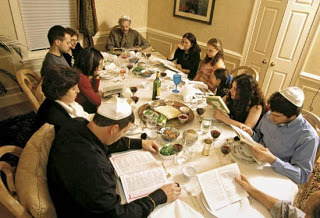 Family Gathered for Their Seder Meal
Family Gathered for Their Seder MealHello My Friend and Welcome.
As we learned in our recent post on the date of Easter, Holy Week and Easter are intimately connected to the week-long Jewish Feast of Pesach, or Passover. With this in mind, today we step aside from our Lenten-Easter posts to take a look at the Feast of Passover…more specifically we'll be examining the Seder Meal.
PESACH IN ANCIENT JUDAISM In ancient times, Passover was the first of three great pilgrim feasts during which all Jews who were able would journey to Jerusalem to celebrate the feast in the Temple. We are told in the Gospels that Jesus made the annual trek to Jerusalem to participate in the festivities both as a child with Mary and Joseph, and as an adult with his disciples. It was during one such journey that he remained behind causing Mary and Joseph to leave the homebound caravan and return to Jerusalem to find him.
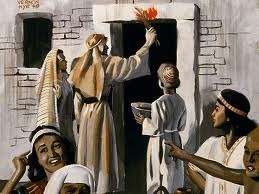 The first Passover occurred in Egypt when the first born of each family died. The Israelites were protected from this curse by slaughtering an unblemished lamb and painting their doorposts and lintel in its blood with a branch of the hyssop plant. (Exodus 12:1-13, 21-28, 43-49) Seeing this mark, the Angel of Death passed over their homes. They are then commanded to celebrate this feast as an annual memorial to the Lord's salvation. The Bible gives specific instructions on how it is to be eaten…standing with staff in hand, etc.
The first Passover occurred in Egypt when the first born of each family died. The Israelites were protected from this curse by slaughtering an unblemished lamb and painting their doorposts and lintel in its blood with a branch of the hyssop plant. (Exodus 12:1-13, 21-28, 43-49) Seeing this mark, the Angel of Death passed over their homes. They are then commanded to celebrate this feast as an annual memorial to the Lord's salvation. The Bible gives specific instructions on how it is to be eaten…standing with staff in hand, etc.THE SEDER MEALBy the First Century, the Pesach meal had evolved into a structured religious service with a defined form of conduct. The word seder, in fact, means order. And there is a particular order of prayers and responses to the Seder meal. Most people distribute prayer books, siddurs, so each family member can follow along and participate. Of all the Jewish holidays, Pesach is the one most Christians are familiar with and also the most commonly observed, even by otherwise non-observant Jews. According to the 1990 survey, more than 80% of Jews have attended a Pesach Seder.
ANNUAL HOUSECLEANINGPesach was also known as the Feast of Unleaven Bread because it is forbidden to eat chametz, leaven, during Pesach. Chametz includes anything made from the five major grains…wheat, rye, barley, oats and spelt, which wasn't completely cooked within 18 minutes after coming into contact with water. Since all of these grains are commonly used to make bread, their use was prohibited to avoid any confusion. The most significant observance related to Pesach involves the removal of all leavened items from the home. This commemorates the Jews leaving Egypt in a hurry, and not having time to let their bread rise. It is also a symbolic way of removing the puffiness —arrogance and pride— from one's soul.
 Commercial MatzahThe grain product eaten during Pesach is called matzah. Matzah is unleavened bread, made from flour and water and cooked very quickly. This is the bread that the Jews made for their flight from Egypt. There are many inventive ways to use matzah. It is available in a variety of textures for cooking: matzah flour, finely ground for cakes and cookies, matzah meal, coarsely ground for use as a bread crumb substitute, matzah farfel, little chunks which serve as a noodle or bread cube substitute, and full-sized matzahs, the 10 inch square that serves as a bread substitute and is an integral part of the Seder meal.
Commercial MatzahThe grain product eaten during Pesach is called matzah. Matzah is unleavened bread, made from flour and water and cooked very quickly. This is the bread that the Jews made for their flight from Egypt. There are many inventive ways to use matzah. It is available in a variety of textures for cooking: matzah flour, finely ground for cakes and cookies, matzah meal, coarsely ground for use as a bread crumb substitute, matzah farfel, little chunks which serve as a noodle or bread cube substitute, and full-sized matzahs, the 10 inch square that serves as a bread substitute and is an integral part of the Seder meal.SETTING THE TABLE…THE SEDER PLATE The first thing that must be done for the meal is to prepare the Seder plate. There are many decrative plates available with a designated spot for each of the six items: The Charoset. a mixture of chopped walnuts, wine, cinnamon and apples that represents the mortar the Jewish slaves used to assemble for the Pharaoh's bricks. Chazeret, freshly grated horseradish to reflect the bitter affliction of slavery. Karpas, a vegetable, most often parsley, which is dipped in salt water as a reminder of the bitter tears the Jews shed while enslaved in Egypt. Betza, or hard-boiled egg. The egg is metaphoric. Like the egg that hardens the more one boils it, so the Israelites strengthened when faced with increasingly challenging situations. The round shape of the egg also reminds us of the cycle of life. The Zro-a, a shank bone symbolic of the sacrificial lamb. The Maror, or bitter herbs…typically Romaine or endive, a remembrance of the bitter affliction of slavery. Each person also receives a glass of wine or grape juice.
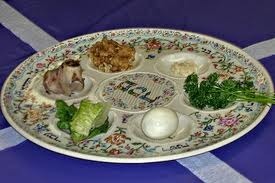 A Seder Plate with the Six Items The order of the meal is best understood as a series of steps, each of which has both historical and symbolic meaning.
A Seder Plate with the Six Items The order of the meal is best understood as a series of steps, each of which has both historical and symbolic meaning.1. Kaddesh: The Sanctification. A blessing is said over wine in honor of the holiday, the wine is drunk, and a second cup is poured.
2. Urechatz: The First Washing. A washing of the hands without a blessing in preparation for eating.
3. Karpas: The vegetable (usually parsley) is dipped in salt water and eaten. Parsley lends itself especially well for this purpose, because when you shake off the salt water, it looks like tears.
4. Yachatz: The Breaking of the matzah. One of the three matzahs on the table is broken. Part is returned to the pile, the other part is set aside for the afikomen for later use.
5. Maggid: The Story. It begins when the youngest person in the room asks the first of the Mah Nishtanah…the four questions. "Why is this night different from all others?" The host or oldest person in the room then tells the story of the Exodus and the first Passover. At the end of the maggid, a blessing is recited over the second cup of wine and it is drunk.
6. Rachtzah: The Second Washing. A second washing of the hands, this time with a blessing, in preparation for the eating the matzah.
7. Motzi: The blessing over Grain Products. The ha-motzi blessing, a generic blessing for bread or grain products used as a meal, is recited over the matzah.
8. Matzah: A blessing specific to matzah is recited, and a bit of matzah is eaten.
9. Maror: The bitter herbs. A blessing is recited over a bitter vegetable, usually raw horseradish, and it is eaten.
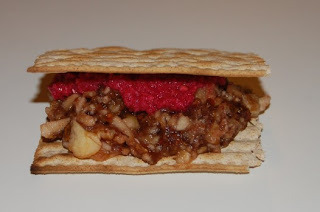 The Hillel Sanwich - Charoset Between Matzah10. Korekh: The Hillel Sandwich. The Rabbi Hillel, who died a few years before Jesus was born, believed the maror should be eaten together with matzah and the paschal offering. Since there are no more animal sacrifices, there is no paschal offering to eat. However, in Hillel's memory, it's customary to eat some maror with charoset between two pieces of matzah.
The Hillel Sanwich - Charoset Between Matzah10. Korekh: The Hillel Sandwich. The Rabbi Hillel, who died a few years before Jesus was born, believed the maror should be eaten together with matzah and the paschal offering. Since there are no more animal sacrifices, there is no paschal offering to eat. However, in Hillel's memory, it's customary to eat some maror with charoset between two pieces of matzah. If you search for Charoset recipes, you'll find them with raisins, dates, cranberries, pears even mangoes. Here is a traditional recipe. For authenticity, you might want to consider sweetening it with honey since the First Century Jews didn't have refined sugar.
Ingredients:6 apples, peeled, cored and coarsely chopped
2/3 c chopped almonds
3 tbsp sugar, or to taste
1/2 tsp cinnamon
Grated rind of 1 lemon
4 tbsp sweet red wine
Combine all, mixing thoroughly. Add wine as need. Blend to desired texture —some like it coarse and crunchy, others prefer it ground to a paste. Makes about 3 Cups. Keeps in refrigerator
11. Shulchan Orekh: The Dinner. A festive meal is now served. There is no particular requirement regarding what to eat at this meal except, of course, chametz cannot be eaten.
12. Tzafun: The Afikomen. The piece of matzah set aside earlier is eaten as dessert, the last food of the meal. Families have different traditions relating to the afikomen. Some have the children hide it, while the parents have to either find it or ransom it back. Others have the parents hide it and the children must find it. Either way, the goal seems to be to keep the children awake and attentive as they wait for this part.
13. Barekh: Grace after Meals. The third cup of wine is poured, and birkat ha-mazon (grace after meals) is recited. This is similar to the grace that would be said on any Shabbat. At the end, a blessing is said over the third cup and it is drunk. A fourth cup is poured, including a cup reserved for the prophet Elijah, who is supposed to herald the Messiah. The door is opened for a while at this point.
14. Hallel: The Praises. Several psalms are recited. A blessing is recited over the last cup of wine and it is drunk. [By the way, this is where our word Hallelujah comes from.]
15. Nirtzah: The Closing. A simple statement that the Seder has been completed, with a wish that next year, it may be celebrated in Jerusalem (i.e., that the Messiah will come within the next year).
Many Christian churches celebrate a Seder meal as a remembrance of the Last Supper. If you have an opportunity to attend such a service, take it. You will find it both instructive and enlightening.
Be sure to check in tomorrow for a traditional recipe that allows you to utilize a lot of those hard- boiled eggs you dyed with the kids.
We'll return on Monday to look at the rite of initiation used by the Early Church.
Until then, we wish Peace and Blessings over the upcoming Easter/Passover weekend.
If you reached this post via a link, click the HOME tab above to see other recent posts and visit our archives.
Published on April 06, 2012 13:00
April 4, 2012
MAUNDY THURSDAY – THE BEGINNING OF THE PASCHAL TRIDUUM
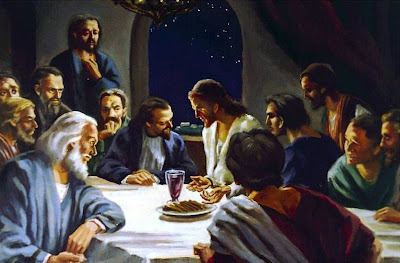 Jesus and his Disciples Celebrate the Last Supper on Maundy ThursdayHello My Friend and Welcome.
Jesus and his Disciples Celebrate the Last Supper on Maundy ThursdayHello My Friend and Welcome. Our Lenten-Easter Series continues with a discussion of Maundy Thursday. In various ages and places it has been known by a variety of names… Clean Thursday, Great Thursday, Green Thursday, Holy and Great Thursday, Holy Thursday, Red Thursday, Sharp Thursday, Sheer Thursday, Shrift Thursday, and Thursday of the Mystical Supper.
UNUSUAL NAMES AND WORDSThe reference to colors may seem confusing at first. However, in the Early Church people dyed their Easter eggs on the Thursday before Easter. The only color they used was red, representing the blood of Christ. There are several explanations for calling it Green Thursday. One theory traces it back to the reconciliation of penitents which took place on this day. The penitents carried green branches as a sign of their joy. Indeed, Dies viridium, an old Latin name for the day which means "Day of the Green Ones," came from this custom. In the symbolic code of the western European church, green represents hope and victory. The green twig in particular symbolized a long struggle crowned by victory. Until the thirteenth century priests wore green vestments on Maundy Thursday.
Another theory suggests that it evolved from an older name, "Mourning Thursday." The two names are not far apart in German since the German word for mourning is grunen and the German word for green is grün. The word Maundy comes from the Latin mandatum, meaning command and refers to the passage in John 13:34 where, at the Last Supper, Jesus says to his disciples, "A new commandment I give to you, that you love one another; even as I have loved you, that you also love one another."
THE LAST SUPPER — BEGINNING OF THE PASSIONMaundy Thursday also begins what is sometimes called the Triduum, or the final three days of Lent…Maundy Thursday, Good Friday and Holy Saturday. Biblically, it begins the Passion of the Christ, to borrow a term, with the narrative of the Last Supper followed by the Agony in the Garden, his arrest, initial trial and eventual crucifixion the following afternoon.
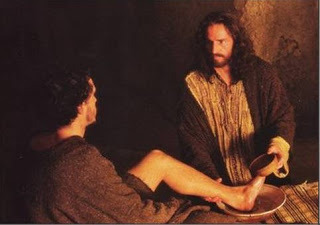 Jesus Washes the Feet of His DiscipleA number of things occurred at the Last Supper and many traditions of our day still reflect this. For instance, Maundy Thursday is the day many churches have a foot washing ceremony. In an imitation of Jesus washing the feet of his disciples, a priest or deacon washes the feet of parishioners. Each year the Greek town of Patmos stages a folk play dramatizing the washing of the disciples' feet. Participants stage the play, titled Niptir, or "Washing," in the town square.
Jesus Washes the Feet of His DiscipleA number of things occurred at the Last Supper and many traditions of our day still reflect this. For instance, Maundy Thursday is the day many churches have a foot washing ceremony. In an imitation of Jesus washing the feet of his disciples, a priest or deacon washes the feet of parishioners. Each year the Greek town of Patmos stages a folk play dramatizing the washing of the disciples' feet. Participants stage the play, titled Niptir, or "Washing," in the town square. The second, and most important, aspect of the Last Supper was the Lord's institution of the sacrament of Eucharist. In doing so he established the New Covenant. The Last Supper was a Passover meal. The doctrine that Jesus became the Paschal Lamb slain for our sins derives from his words and actions on Maundy Thursday.
Many Protestant churches celebrate the Lord's Supper on Maundy Thursday. Others use the occasion to have a modified Seder meal known as an Upper Room service. Members gather to eat foods Jesus and his disciples may have included in their Passover meal. They eat in silence, while listening to Bible readings. The name derives from the place where Jesus and his disciples ate the Last Supper, which the Bible called simply as the upper room.
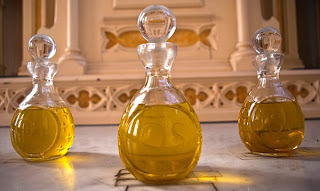 Vials of Chrism (Holy Oil) Waiting to be BlessedBLESSING THE CHRISM AND ANOINTING THE SICKIn Catholic and Anglican cathedrals the holy oil, or chrism, that will be used in the coming year is blessed at a special service on Maundy Thursday. Clergy members use this oil for baptisms, confirmations, ordinations, and for anointing the dying and those in ill health. This practice of blessing of holy oil on Maundy Thursday can be traced back to at least the Fifth Century.
Vials of Chrism (Holy Oil) Waiting to be BlessedBLESSING THE CHRISM AND ANOINTING THE SICKIn Catholic and Anglican cathedrals the holy oil, or chrism, that will be used in the coming year is blessed at a special service on Maundy Thursday. Clergy members use this oil for baptisms, confirmations, ordinations, and for anointing the dying and those in ill health. This practice of blessing of holy oil on Maundy Thursday can be traced back to at least the Fifth Century. In the Eastern, or Orthodox Church, Maundy Thursday services commemorate the Last Supper and Jesus' command to his disciples to love one another. Since Orthodoxy follows the ancient Jewish custom of reckoning the start of each new day at sunset, their Maundy Thursday services begin on Wednesday evening. In some places Wednesday evening services are accompanied by the anointing of the sick.
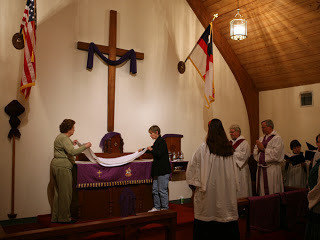 STRIPPING THE ALTAR
STRIPPING THE ALTARIn some churches the altar is ceremonially stripped of all its cloth coverings at the end of Maundy Thursday services. This stripping leaves the church with a stark appearance. Just as Jesus was taken away by the soldiers, the altar in a sense is taken away. This prepares the Church for the mournful services that take place the following day on Good Friday. It also gives those in charge of cleaning and decorating the church an opportunity to wash everything thoroughly in preparation for Easter. In the Middle Ages the floors and walls of the church were scrubbed on Maundy Thursday, sometimes called Clean Thursday. However this most likely derived not from washing the church, but from the practice of encouraging people to bathe and clean their clothes on Maundy Thursday in preparation for Easter.
SYMBOLIC COLORSIn Catholic churches, as well as those Protestant churches that observe liturgical colors, these instructions govern the color of clerical robes and other church decorations throughout the year. Priests wear red robes at the start of Maundy Thursday services since in the liturgical color scheme red represents love and suffering. At the celebration of the Eucharist the priest changes to white robes, symbolizing joy. This switch reflects the honor given to Maundy Thursday as the birthday of the Eucharist and the joy with which Christians receive this gift from Christ.
FLYING BELLSIn another old church custom that dates back to the Eighth Century, bells were rung for the last time before Easter on Maundy Thursday. In the absence of the bells the beginning and ending of religious services and devotions were announced by the sounding of a wooden clapperboard, an ancient device used in churches before the introduction of bells in the Fifth Century. This sudden silence of the church bells puzzled children. Adults often told them the bells had flown off to Rome to visit the pope and spend the night at St. Peter's before returning on Easter morning. French parents even hinted it was the returning bells that brought children their Easter eggs. Take that, Mr. Easter Bunny!
Out of respect for Passion Week, there will be no post on Maundy Thursday or Good Friday. Be sure to check at Sowing the Seeds on Saturday. We'll have a short post on what to do with all the Easter eggs which includes a recipe.
Until then, we wish you Peace and Blessings.
If you reached this post via a link, click the HOME tab above to see other recent posts and visit our archives.
Published on April 04, 2012 14:52
MAUNDY THURSDAY – THE BEGINNING OF THE TRIDIUM
 Jesus and his Disciples Celebrate the Last Supper on Maundy ThursdayHello My Friend and Welcome.
Jesus and his Disciples Celebrate the Last Supper on Maundy ThursdayHello My Friend and Welcome. Our Lenten-Easter Series continues with a discussion of Maundy Thursday. In various ages and places it has been known by a variety of names… Clean Thursday, Great Thursday, Green Thursday, Holy and Great Thursday, Holy Thursday, Red Thursday, Sharp Thursday, Sheer Thursday, Shrift Thursday, and Thursday of the Mystical Supper.
UNUSUAL NAMES AND WORDSThe reference to colors may seem confusing at first. However, in the Early Church people dyed their Easter eggs on the Thursday before Easter. The only color they used was red, representing the blood of Christ. There are several explanations for calling it Green Thursday. One theory traces it back to the reconciliation of penitents which took place on this day. The penitents carried green branches as a sign of their joy. Indeed, Dies viridium, an old Latin name for the day which means "Day of the Green Ones," came from this custom. In the symbolic code of the western European church, green represents hope and victory. The green twig in particular symbolized a long struggle crowned by victory. Until the thirteenth century priests wore green vestments on Maundy Thursday.
Another theory suggests that it evolved from an older name, "Mourning Thursday." The two names are not far apart in German since the German word for mourning is grunen and the German word for green is grün. The word Maundy comes from the Latin mandatum, meaning command and refers to the passage in John 13:34 where, at the Last Supper, Jesus says to his disciples, "A new commandment I give to you, that you love one another; even as I have loved you, that you also love one another."
THE LAST SUPPER — BEGINNING OF THE PASSIONMaundy Thursday also begins what is sometimes called the Triduum, or the final three days of Lent…Maundy Thursday, Good Friday and Holy Saturday. Biblically, it begins the Passion of the Christ, to borrow a term, with the narrative of the Last Supper followed by the Agony in the Garden, his arrest, initial trial and eventual crucifixion the following afternoon.
 Jesus Washes the Feet of His DiscipleA number of things occurred at the Last Supper and many traditions of our day still reflect this. For instance, Maundy Thursday is the day many churches have a foot washing ceremony. In an imitation of Jesus washing the feet of his disciples, a priest or deacon washes the feet of parishioners. Each year the Greek town of Patmos stages a folk play dramatizing the washing of the disciples' feet. Participants stage the play, titled Niptir, or "Washing," in the town square.
Jesus Washes the Feet of His DiscipleA number of things occurred at the Last Supper and many traditions of our day still reflect this. For instance, Maundy Thursday is the day many churches have a foot washing ceremony. In an imitation of Jesus washing the feet of his disciples, a priest or deacon washes the feet of parishioners. Each year the Greek town of Patmos stages a folk play dramatizing the washing of the disciples' feet. Participants stage the play, titled Niptir, or "Washing," in the town square. The second, and most important, aspect of the Last Supper was the Lord's institution of the sacrament of Eucharist. In doing so he established the New Covenant. The Last Supper was a Passover meal. The doctrine that Jesus became the Paschal Lamb slain for our sins derives from his words and actions on Maundy Thursday.
Many Protestant churches celebrate the Lord's Supper on Maundy Thursday. Others use the occasion to have a modified Seder meal known as an Upper Room service. Members gather to eat foods Jesus and his disciples may have included in their Passover meal. They eat in silence, while listening to Bible readings. The name derives from the place where Jesus and his disciples ate the Last Supper, which the Bible called simply as the upper room.
 Vials of Chrism (Holy Oil) Waiting to be BlessedBLESSING THE CHRISM AND ANOINTING THE SICKIn Catholic and Anglican cathedrals the holy oil, or chrism, that will be used in the coming year is blessed at a special service on Maundy Thursday. Clergy members use this oil for baptisms, confirmations, ordinations, and for anointing the dying and those in ill health. This practice of blessing of holy oil on Maundy Thursday can be traced back to at least the Fifth Century.
Vials of Chrism (Holy Oil) Waiting to be BlessedBLESSING THE CHRISM AND ANOINTING THE SICKIn Catholic and Anglican cathedrals the holy oil, or chrism, that will be used in the coming year is blessed at a special service on Maundy Thursday. Clergy members use this oil for baptisms, confirmations, ordinations, and for anointing the dying and those in ill health. This practice of blessing of holy oil on Maundy Thursday can be traced back to at least the Fifth Century. In the Eastern, or Orthodox Church, Maundy Thursday services commemorate the Last Supper and Jesus' command to his disciples to love one another. Since Orthodoxy follows the ancient Jewish custom of reckoning the start of each new day at sunset, their Maundy Thursday services begin on Wednesday evening. In some places Wednesday evening services are accompanied by the anointing of the sick.
 STRIPPING THE ALTAR
STRIPPING THE ALTARIn some churches the altar is ceremonially stripped of all its cloth coverings at the end of Maundy Thursday services. This stripping leaves the church with a stark appearance. Just as Jesus was taken away by the soldiers, the altar in a sense is taken away. This prepares the Church for the mournful services that take place the following day on Good Friday. It also gives those in charge of cleaning and decorating the church an opportunity to wash everything thoroughly in preparation for Easter. In the Middle Ages the floors and walls of the church were scrubbed on Maundy Thursday, sometimes called Clean Thursday. However this most likely derived not from washing the church, but from the practice of encouraging people to bathe and clean their clothes on Maundy Thursday in preparation for Easter.
SYMBOLIC COLORSIn Catholic churches, as well as those Protestant churches that observe liturgical colors, these instructions govern the color of clerical robes and other church decorations throughout the year. Priests wear red robes at the start of Maundy Thursday services since in the liturgical color scheme red represents love and suffering. At the celebration of the Eucharist the priest changes to white robes, symbolizing joy. This switch reflects the honor given to Maundy Thursday as the birthday of the Eucharist and the joy with which Christians receive this gift from Christ.
FLYING BELLSIn another old church custom that dates back to the Eighth Century, bells were rung for the last time before Easter on Maundy Thursday. In the absence of the bells the beginning and ending of religious services and devotions were announced by the sounding of a wooden clapperboard, an ancient device used in churches before the introduction of bells in the Fifth Century. This sudden silence of the church bells puzzled children. Adults often told them the bells had flown off to Rome to visit the pope and spend the night at St. Peter's before returning on Easter morning. French parents even hinted it was the returning bells that brought children their Easter eggs. Take that, Mr. Easter Bunny!
Out of respect for Passion Week, there will be no post on Maundy Thursday or Good Friday. Be sure to check at Sowing the Seeds on Saturday. We'll have a short post on what to do with all the Easter eggs which includes a recipe.
Until then, we wish you Peace and Blessings.
If you reached this post via a link, click the HOME tab above to see other recent posts and visit our archives.
Published on April 04, 2012 01:00
April 2, 2012
RELICS OF CHRIST'S PASSION & DEATH: THE SHROUD OF TURIN
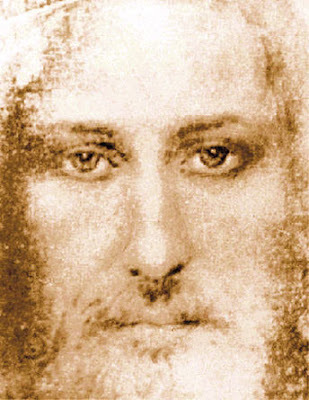 The Man Whose Image Appears on the Shroud
The Man Whose Image Appears on the ShroudHello My Friend and Welcome.
Today we examine the third, and final, Relic of Christ's Passion & Death — the Shroud of Turin. The length of this post exceeds our norm, but given the topic only a thorough discussion will do it justice. Before we begin, there's an issue we must be address. If you missed our two earlier posts on Veronica's Veil, you can see it HERE. And if you missed the post on the Sudarium, you can find it HERE.
DENIAL OF THE POSSIBILITY OF IT BEING A RELIC
You frequently hear that the Shroud is a forgery. Something created by a skillful 13th Century artisan. It's even been speculated that some unknown religious fanatic intent on creating a relic actually beat, tortured, and crucified some poor soul just to create an authentic looking shroud. People express pity and lament for this nameless individual who died producing the image. As with so many falsehoods, this nonsense is easily refuted by fact.
Many, many scientists have studied the Shroud. Some came to the work as atheists, others as skeptics, and some as agnostics. Interestingly enough, of the two thousand scientists who have studied the Shroud, 95% of them eventually converted to Christianity. Such is its power.
Consider this, suppose someone placed a piece of cloth in your arms and said, "This has been absolutely, positively verified to be the cloth that wrapped the body of Yeshua of Nazareth, the man we know as Jesus Christ." What would you feel?
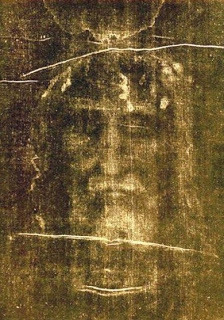 Facial Image from the ShroudTourists visit the Wailing Wall in Jerusalem primarily because it is all that remains of Herod's Temple and the wall was there when Jesus lived. People walk the Via Dolorosa because Jesus trod those same paving stones on his way to Golgotha. The whole purpose of visiting the Holy Land is to see, hear, feel and experience the places where Jesus lived. And yet all of these experiences pale when compared to holding the cloth that wrapped his body in your arms.
Facial Image from the ShroudTourists visit the Wailing Wall in Jerusalem primarily because it is all that remains of Herod's Temple and the wall was there when Jesus lived. People walk the Via Dolorosa because Jesus trod those same paving stones on his way to Golgotha. The whole purpose of visiting the Holy Land is to see, hear, feel and experience the places where Jesus lived. And yet all of these experiences pale when compared to holding the cloth that wrapped his body in your arms. STUDYING THE SHROUD ITSELFThe cloth of the shroud is not your typical burial linen. It is very fine cloth with a three-by-one herringbone twill weave. By comparison, Cleopatra's burial shroud was not made of cloth anywhere near as nice. There is a legend which says it was the tablecloth used at the Last Supper. This could possibly be true since no one pre-planned his burial and time was of the essence due to the approaching sundown. They very well may have used it for expediency. Support for this theory comes from drip patterns on one side of the Shroud. It appears as if perhaps a piece of bread was dipped in sauce and then passed to others. Recall that at the time of Jesus, they ate on only one side of the table. They reclined with the table in front of them and servants brought food and utensils from the opposite side. Jewish law prohibited passing food behind someone.
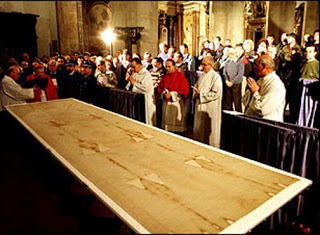 Presenting the Shroud for Scientific AnalysisANALYZING THE IMAGEThe popular belief is that the image on the Shroud is a contact image. This is false. There are places where the shroud clearly touched the body, but others where it just as clearly did not. Yet the image is complete and coherent. If you want an example of a contact image, visit our earlier post on the Sudarium HERE.
Presenting the Shroud for Scientific AnalysisANALYZING THE IMAGEThe popular belief is that the image on the Shroud is a contact image. This is false. There are places where the shroud clearly touched the body, but others where it just as clearly did not. Yet the image is complete and coherent. If you want an example of a contact image, visit our earlier post on the Sudarium HERE. There is also no paint or pigment on the cloth and no brush strokes of any kind. The image resulted from the oxidation of the top six microns, less than the thickness of a human hair, of the linen fibrils. In other words, it is essentially a scorch.
Current thinking suggests the image was burned onto the cloth by the intense burst of radiant energy, light and heat, occurring at the instant of the Lord's Resurrection. The image is essentially a photographic negative. Therefore, the negative of a photo of the Shroud displays the positive. The Shroud was first photographed in 1898. Only when they developed the plate did its fine details became apparent; most can't be seen with the naked eye.
The reason for this photographic effect again, relates to the light, energy, and radiation of the Resurrection. Perhaps you've seen or heard of similar occurrences in Hiroshima. If a person happened to be passing a building at the time of detonation, they would have been instantly vaporized. However, in the process, a photographic negative image of them was burned into the wall beside them…their shadow was flashed onto the wall.
Like Veronica's Veil and the Sudarium, the Shroud has been subjected to NASA three-dimensional imaging software. Place a photo of the Shroud under their equipment and you get a perfect 3-D image. A typical photograph or painting becomes distorted when subjected to the same process. The shroud is the only object in the world that, when its photograph is placed under this analyzer, produces a perfect 3-D image of a human being.
The image on the Shroud is also anatomically correct in all details. The wounds, blood patterns, etc., all correspond to what we know of the wounds Christ suffered. The man in the Shroud was 5'11" tall and weighed about 175 pounds. He was Jewish, in good health between the age of 30 and 35.
POLLEN ANALYSISA Swiss criminologist gathered samples of 58 species of pollen off of the Shroud. Forty-five of them are from Jerusalem and the surrounding area. We have an exact history of the shroud from the year 1350 forward. If it originated in Europe at that time, how did it acquire all this pollen from the Holy Land? Of those 45, 18 of them are found nowhere else but in the Holy Land. A Jewish scientist and expert in pollen stated unequivocally that he has no doubt the Shroud originated in the area between Jerusalem and Jericho. Interestingly, most of this pollen comes from plants that bloom in the spring, which is, of course, when the crucifixion took place.
OTHER SCIENTIFIC ANALYSISUltraviolet analysis of the shroud shows blood serum halos around the blood stains. Such a detailed understanding of blood chemistry and ultraviolet technology was unknown in the 14th century.
In addition to soft tissue information, the shroud also shows bone. In some respects, the intense burst of radiation produced an X-ray effect. Under magnification, teeth can be detected through a closed mouth. Ribs, vertebrae and other bone structure can also be seen. When looking at photos of the Shroud, you may have wondered why the fingers appear so long. This is because you are seeing the metacarpal bones that form the hand itself. Images of the thumb can even be seen through the hand.
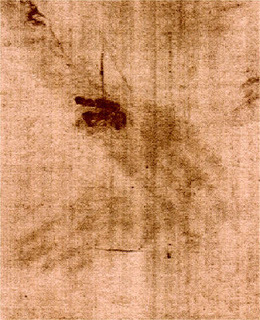 Bloodstain from Wound Through the Wrist
Bloodstain from Wound Through the WristNotice also, where the nail marks are in the hands. They're not in the hands, but in the wrists. Studies have shown that a nail in the hand, as most artists depict it, would not support the weight of a human body. In the wrist bone, however, there is a small opening that allows the nail to slip through and hold fast.
OFF BODY IMAGESThere are other images on the Shroud in addition to a man's body. For instance, before he was buried, they attached a phylactery to his forehead. This and his hairstyle is how we know he was Jewish. Phylacteries were small leather pouches that Jews of that day tied around their head and left arm in fulfillment of the command in Deuteronomy 6:4-9, "And these words which I command you this day shall be upon your heart; and you shall teach them diligently to your children, and shall talk of them when you sit in your house, and when you walk by the way, and when you lie down, and when you rise. And you shall bind them as a sign upon your hand, and they shall be as frontlets between your eyes. And you shall write them on the doorposts of your house and on your gates."
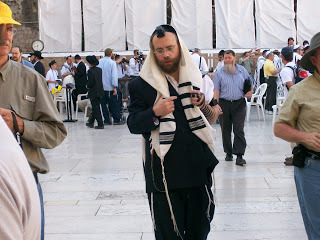 Man Wearing a PhylacteryVerse nine relates not to phylacteries, but to the mezuzahs, or scroll cases, Jews attach to their door posts even to this day. Inside both would be a small scroll containing the words of the Shema. In Hebrew, the prayer that proceeds the command in Deuteronomy begins, Sh'ma Yisrael Adonai eleheinu Adonai ehad… "Hear, O Israel: The LORD our God is one LORD…and you shall love the LORD your God with all your heart, and with all your soul, and with all your might."
Man Wearing a PhylacteryVerse nine relates not to phylacteries, but to the mezuzahs, or scroll cases, Jews attach to their door posts even to this day. Inside both would be a small scroll containing the words of the Shema. In Hebrew, the prayer that proceeds the command in Deuteronomy begins, Sh'ma Yisrael Adonai eleheinu Adonai ehad… "Hear, O Israel: The LORD our God is one LORD…and you shall love the LORD your God with all your heart, and with all your soul, and with all your might." Three-D imaging done in the 1970's also showed coins on the man's eyelids. With detailed analysis, the coin itself was identified. It was found to be a lepton. Leptons circulated in Judea at the time of Tiberius Caesar. They were minted in AD 29 during the reign of Judean Prefect Pontius Pilate.
WHAT ABOUT THE CARBON-14 DATING?In 1988, to the naysayers delight, the Vatican authorized a Carbon-14 test. The results dated the cloth to the 14th Century — somewhere between 1290 and 1360 to be exact. End of story, right? The Shroud's clearly a fake, a forgery, a fraud. Not quite.
Like many modern analytic tools, the reputation that Carbon-14 Dating has for accuracy is seriously overstated. It is definitely a useful scientific tool, but it depends upon skillful interpretation, multiple samples, and knowing the surrounding strata in which an object was found. But there is no surrounding strata; the Shroud was not recovered in an archeological dig. And, as you will see, the outcome of the much reported 1988 tests resulted from flawed science. Could someone have deliberately attempted to skew the results? You decide.
The 1988 tests used three postage stamp sized samples. The stated plan was to take them from three different areas. However, the researchers in charge violated this protocol and took them all from the same region. Under magnification, the site where they took the sample was also shown to have a slightly different weave pattern than the rest of the material. When this occurred, no one knows. What is known is that at some point in time it had been re-woven, perhaps during the Middle Ages, to repair earlier damage.
Because of these and similar mistakes, their work did not pass peer review by other scientists, making it essentially a worthless exercise. Results could not be published in any of the respected scientific journals such as Radio Carbon, American Journal of Chemistry, American Journal of Archaeology, etc. Instead, the results were published in the popular magazine, Nature, with no peer review.
Over the years, the Shroud has been in three recorded fires. The worst one occurred in 1532. This fire was so hot that it melted the silver overlay on the Shroud's case sending molten silver dripping onto the Shroud. Silver, by the way, melts at 920 degrees centigrade. Since the Shroud was folded at the time, this resulted in 24 holes. The patches over those spots are easily seen in photos. The place where they took their sample was quite near a burned segment, meaning the cloth they took had been subjected to extreme heat.
When a piece of linen undergoes such an intense fire, it causes a caboxylation of its glucose structure making it appear younger than it is. Russian scientists tested the effect fire had on the Carbon 14 dating of linen. They took a piece of linen that tested 2,000 years old and subjected it to heat similar to the 1532 fire. When the linen was retested, they found the heat caused a 700 to 1,300 year shift in the results, causing the linen to appear much younger than it actually was. Carbon-14 testing on mummies reveals that the mummy itself reads 300-600 years older than the linen they're wrapped in.
BACTERIA AND MICROORGANISMSAs you know, microorganisms are in the air we breathe, on our skin, our clothing, our furniture…everywhere. The University of Texas studied the microorganisms found on the Shroud. Because it has been exhibited publicly so many times, a number of various bacteria had settled on the cloth. The presence of bacteria and other microorganisms is known to distort Carbon-14 Dating.
THE ISSUE OF CIRCUMSTANTIAL EVIDENCE
I'm sure we've all seen TV crime shows or movies in which the defense attorney tells the dogged investigator, "That's all circumstantial evidence. You have no corpse, no fingerprints. You can't prove my client did it. No jury will ever convict him based on merely circumstantial evidence."
Meanwhile, we the viewer know his client is guilty as sin. The point being, when an overwhelming preponderance of circumstances all lead to a single conclusion, and at the same time eliminate all other possibilities, the only reasonable course of action is to accept those findings. Remember the little name tags your mother had to sew into your clothes before you left for summer camp? Unfortunately, no one bothered to sew a tag on the Shroud that read, "This shroud belongs to Jesus of Nazareth, if lost, please return."
 Full Shroud - Back and FrontOr perhaps they did.
Full Shroud - Back and FrontOr perhaps they did. In a report entitled The Shroud of Turin, The Holographic Experience given by Dr. Petrus Soons states, "My presentation summarizes work connected with digitizing Shroud photographs taken by Giuseppe Enrie in 1931, enhancing the digitized images to improve details, translating the enhanced images "gray scale data into depth data", generating a sequence of up to 625 images of each of these, and combining these images with a Holoprinter to produce holograms (3D images) of the Shroud. It also summarizes my study of these holograms and discovery of heretofore unseen details, which confirm many previous findings and reveal some surprises." One of those surprises was what he calls The Letters. While enlarging the photos he discovered the image of an unknown object with three letters on it lying under the man's beard. The Aramaic word Ayin-Aleph-Nun means: "The Lamb", a clear reference to Jesus Christ, The Lamb of God. If you wish to read the full report of The Ohio State University Conference, here's a LINK. If you prefer, you can watch the video below which also deals with the written clues on the Shroud.
SUMMING IT UP
Let's play Perry Mason for a few moments. We'll put Mr. Skeptic on the witness stand and see how he interprets all of this circumstantial evidence. Then Perry can bring out the Shroud, which cannot be accurately dated. Opening it across a table he'll ask him to tell us whether, it is, or is not, the burial cloth of Jesus of Nazareth?
But, before he does that, Perry will sum of the facts for the jury:
1.The Shroud displays the image of coins minted in Judea in 29 AD.
2. The Shroud also displays off body images of flowers that grow and bloom in the spring time…the time of the crucifixion. Co-incidentally, there are many early paintings of Christ's burial that depict his body surrounded by flowers.
3. The person wrapped in the Shroud was of the proper age and religion.
4. The wounds to his body correspond exactly with those described in the Gospel accounts.
5. There is no paint or pigment anywhere on the Shroud's image.
6. The blood flows match the expected gravitational pattern.
7. The wounds greatly exceed what is typically portrayed in paintings by the Great Masters, and we all know how much flack Mel Gibson got for doing that in The Passion of the Christ.
8. The image on the Shroud is anatomically correct in every detail.
9. The image on the Shroud also aligns with one of the earliest and most famous ikons of Jesus, Christ Pantokarator, which is often taken as proof the Early Church knew of its existence.
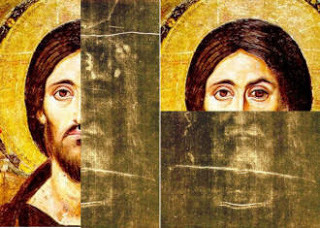 The Shroud Overlaid on Christ Pantocrator10. And last, but not least, it corresponds in every detail with both the image on Veronica's Veil and the Sudarium, both of which are correctly dated to the First Century.
The Shroud Overlaid on Christ Pantocrator10. And last, but not least, it corresponds in every detail with both the image on Veronica's Veil and the Sudarium, both of which are correctly dated to the First Century. At this point, Perry points out that there are only two possibilities. A. The Shroud is what it is purported to be, or…
B. Some immensely skilled individual living in the 14th Century possessed scientific and medical knowledge not discovered until four or five centuries later. Relying upon this secret knowledge and their skill, they somehow created an image on a piece of cloth without using paint or pigment. Then, knowing their work might someday be called into question they acquired a byssus scarf and imprinted an identical facial image on it. To further substantiate their work they made a three dimensional cast of their image, obtained blood, faked wounds and created a Sudarium.
Once the three forgeries were complete, they cleverly dispersed them to different locations making sure they were properly recognized and venerated. To do this required the use of a time machine since each of the Relics has a different pedigree. Nevertheless, they then traveled back in time between 700 and 1,000 years to various places and civilizations. At each stop they forged letters, dispatches, and other documents, both Christian and Muslim, referencing the images they'd just created. With all that done, they returned to their own time and took a well-deserved rest. Spent, no doubt, congratulating themselves on their cleverness. Unfortunately, they could never take credit for this scheme of theirs. Because if they did, all the work they did would collapse in an instant.
Perry now turns and approaches the witness stand. He rests an elbow on the railing. Leaning forward, he looks you in the eye and asks, "Well, what say you?"
The next time we'll look at the traditions of Maundy Thursday, the day before Good Friday.
Until then, we wish you Peace and Blessings.
If you reached this post via a link, click the HOME tab above to see other recent posts and visit our archives.
Published on April 02, 2012 01:00
March 30, 2012
RELICS OF CHRIST'S PASSION & DEATH: THE SUDARIUM
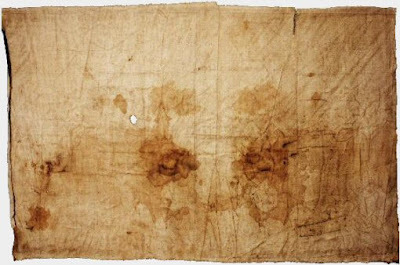 Sudarium of Oviedo
Sudarium of OviedoHello My Friend and Welcome.
In our last post we looked at Veronica's Veil, which was used to wipe the face of Jesus on his way to crucifixion. If you missed it, you can see it HERE. Today we examine the second relic of Our Lord's crucifixion, death and burial…the Sudarium. Latin for sweat cloth, it is sometimes referred to as the other shroud. It is the cloth placed over Jesus' face and head after he died.
JEWISH PRACTICE OF USING A SUDARIUMScientists believe such a cloth was placed put over the head of a corpse as part of Jewish custom…the functional equivalent of a closed casket. When a person's death was so awful that the family did not wish to see the face going into rigor mortis, they covered the head and face with a cloth prior to burial.
The Sudarium is mentioned in John 20:4-7. "They both ran, but the other disciple outran Peter and reached the tomb first; and stooping to look in, he saw the linen cloths lying there, but he did not go in. Then Simon Peter came, following him, and went into the tomb; he saw the linen cloths lying, and the napkin, which had been on his head, not lying with the linen cloths but rolled up in a place by itself."
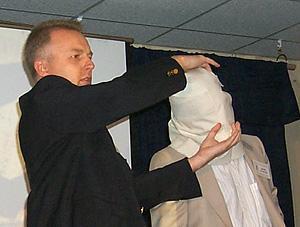 Demonstrating the Use of a Sudarium HOW A SUDARIUM WAS USED
Demonstrating the Use of a Sudarium HOW A SUDARIUM WAS USEDThe cloth would have been placed over Jesus' face after he died to spare his mother additional anguish. They undoubtedly left his face covered as they carried him to the tomb. When they were ready to place the body in the shroud for burial, the Sudarium would have been removed. This explains John's comment that it was rolled up and off to one side.
As we know from the Bible, the custom at that time required a strict observance of the Shabbat. The Pharisees criticized Jesus for healing on the Sabbath and also complained about his disciples "winnowing" grain when the plucked a few heads of wheat and rubbed off the husks with their fingers. No work of any kind was allowed on the Sabbath. This required a lot of pre-planning since anything forgotten had to be left undone.
This necessitated a day of preparation —Friday, since Shabbat was Saturday— at the end of each week. However, earlier in John's Gospel he tells us it was the day of preparation for the most solemn Shabbat of the year. This would have been the Shabbat Chol HaMoed Pesach ―the Sabbath that occurred during the feast of Passover― the most sacred Shabbat of the year.
Some people assume the many blood stains on the shroud indicate the individuals preparing him for burial were in too much of a rush to stop and wash the body. By Jewish reckoning the day ended at sundown, so they were clearly working against the clock, if you will. However, that is not why they didn't wash Jesus' body.
The Jews believed that life was in the blood. When a person died a violent death, and his lifeblood saturated his clothing, there was no taharah — washing. The corpse remained unwashed because blood is part of the body and cannot be separated from it in death. This also explains why the Sudarium was set aside in the tomb rather than disposed of. It was being buried with him just as a person's bloody clothing would have been buried with them.
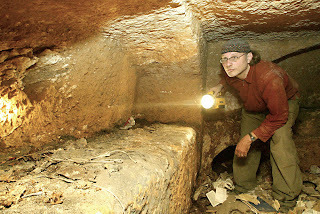 Archaeologist Exploring a Burial Niche in Ancient Tomb JEWISH BURIAL PRACTICESTombs of the Second Temple Period were caves cut into hillsides designed for multiple burials. Inside, they had niches along one or both side walls, somewhat like the catacombs in Rome. In Jesus' day the practice of secondary burial was common. The body would remain in the niche for a year and then, after decomposition had occurred, the bones would be gathered and placed in an ossuary or bone box. The box would be labeled with the name or names of the deceased inside.
Archaeologist Exploring a Burial Niche in Ancient Tomb JEWISH BURIAL PRACTICESTombs of the Second Temple Period were caves cut into hillsides designed for multiple burials. Inside, they had niches along one or both side walls, somewhat like the catacombs in Rome. In Jesus' day the practice of secondary burial was common. The body would remain in the niche for a year and then, after decomposition had occurred, the bones would be gathered and placed in an ossuary or bone box. The box would be labeled with the name or names of the deceased inside. The box would be stored on a shelf in the back of the cave freeing the niche for another burial. Thus a tomb could be used for entire families over several generations. Tombs were sealed with a large stone – typically round and flat like a millstone. The stone was fitted into a sloping groove cut in front of the tomb's entrance allowing it to be rolled back and secured with a chock. Once the work inside the tomb was completed, the chock was released and the stone rolled back over the entrance.
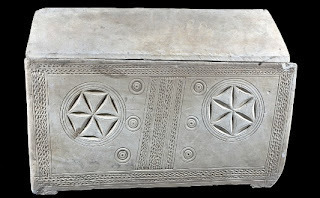 Typical Ossuary or Bone BoxFor additional information on ossuaries and the co-mingling of bones, refer to our previous post The Men Who Tried Jesus — Joseph Caiaphas HERE.
Typical Ossuary or Bone BoxFor additional information on ossuaries and the co-mingling of bones, refer to our previous post The Men Who Tried Jesus — Joseph Caiaphas HERE. THREE SETS OF STAINSUnlike the Veil and the Shroud, the Sudarium has no image on it. Instead, it contains multiple stains consisting of blood and lymph fluid. The linen of the Shroud is a fine herringbone weave, while the Sudarium is a rough weave and looks like muslin. There are three sets of stains on the Sudarium.
FIRSTThe first set of stains is coagulated blood from the crowning of thorns. The Sudarium would have been over the head of Jesus for about 45 minutes. During that time Joseph of Arimathea went to Pilate for permission to remove the body from the cross. We don't know if the patibulum, the crossbar of the cross, was taken down or only the body removed.
SECONDTaking the body down resulted in a second set of stains. The cause of death in crucifixion is asphyxiation, fluid building up in the lungs. This fluid is six parts lymph and one part blood. When the body is placed in a horizontal position following asphyxiation, this fluid exits through the mouth and nose. Scientists can calculate how long the body was in the horizontal position from the stains on the Sudarium.
THIRDLifting the body to transport it to the tomb caused yet a third set of stains. There is a thumb print on the Sudarium where someone, perhaps Joseph of Arimathea or Nicodemus, held it against the face of Jesus. Scientists can estimate the size of that person from the size of their thumbprint.
SCIENTIFIC VERIFICATIONAs we said in our post on Veronica's Veil, nothing will convince the skeptics. In the final analysis relics are more about faith than science. Recall also that Veronica's Veil has been measured and compared to the Shroud of Turin and experts concluded they were images of the same man.
Even thought it displays no image, the markings on the Sudarium do show distinct facial geometry, i.e. cheekbones, brow ridge, eyebrows, etc.. Because Jesus had been so badly beaten, there are precise blood marks of the face on the Sudarium. Using special 3-D technology, NASA scientists placed the image of the Sudarium and the shroud over each other and they aligned perfectly. For most of us the pattern doesn't make sense, but forensic scientists can use the stains to judge the size of the skull, the length of the nose, etc. In one corner of the Sudarium there are three dots from three puncture marks of the crown of thorns.
TRACKING THE SUDARIUM'S TRAVELSThough it originated in Jerusalem, the Sudarium has been in Oviedo, Spain since the 800's. The trail it took to get there and the protection it received along the way is an interesting tale of close calls and narrow escapes reminiscent of an Indiana Jones movie.
When the Persians invaded Palestine in 614, Philip the presbyter led the Christian community south to North Africa. The bishop of Alexandria mentions he welcomed them and they were carrying relics, including a precious relic of Jesus. When Persia invaded Africa a group of Christians sailed to Spain. There is an account in Toledo that says the fleeing Christians they received brought a holy ark with them. At that time the Sudarium was kept in a large oak box.
In 711, the Moors —Muslims— invaded Spain. Islamic writings state, "The Christians fled north taking their precious relics with them." The Muslims had their own relics of Mohammad so it is significant that they mentioned Christian relics. A regional council of bishops in Bravo, Portugal, refers to the relic of Christ being kept in the north of Spain in a sacred ark and hidden in the mountains. In 813, Alphonso II, the King of Asturias, began the recovery of Spain from the Moors. When he established Oviedo as his court, he brought the reliquary from the mountain hideaway to his palace. He built the Camara Santa, a special chapel within his palace to hold the Sudarium. Interestingly, he is also the king who had the basilica built over the tomb of St James in Santiago de Compostela. The Sudarium has remained in Oviedo ever since.
Over the centuries, knowledge of the Sudarium's existence was gradually lost. Then Msgr. Ricci, who was studying the Shroud, went through church archives and discovered references to another cloth which had been in Oviedo for over a thousand years. He went there in 1969, saw it, and decided to have it tested. As we noted earlier, this testing corroborates its authenticity and congruence with the Veil and the Shroud. In 1987 they formed the Spanish Society for the Study of the Sudarium which has greatly increased awareness of the Sudarium's existence.
The next and final post in this group on the Relics of Christ's Passion & Death will deal with the more famous Shroud of Turin.
Until then, we wish you Peace and Blessings.
If you reached this post via a link, click the HOME tab above to see other recent posts and visit our archives.
Published on March 30, 2012 01:00



